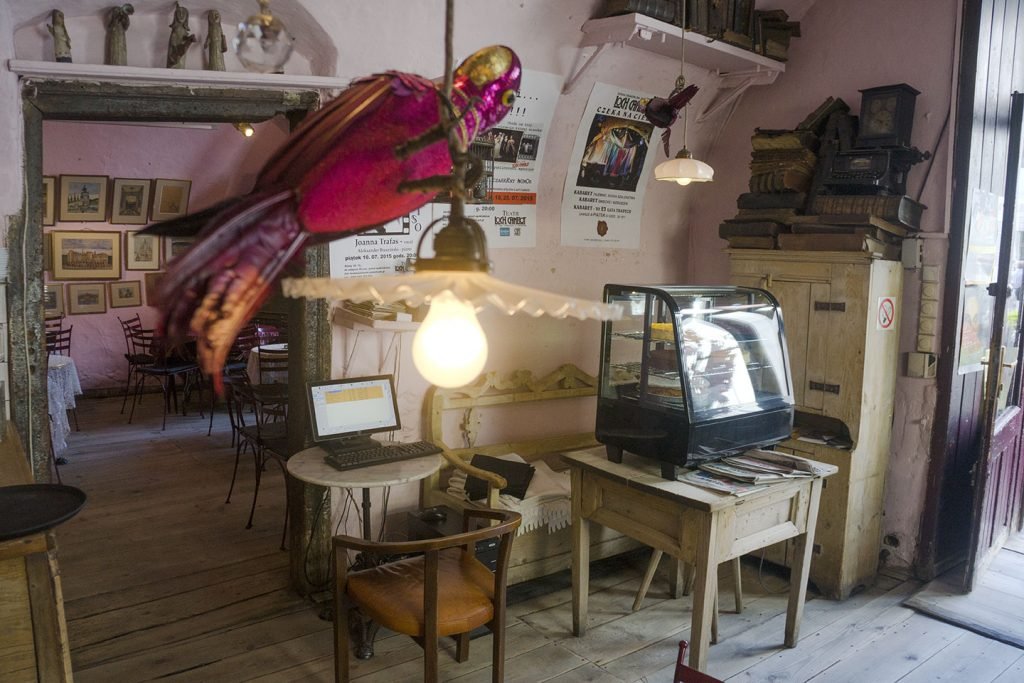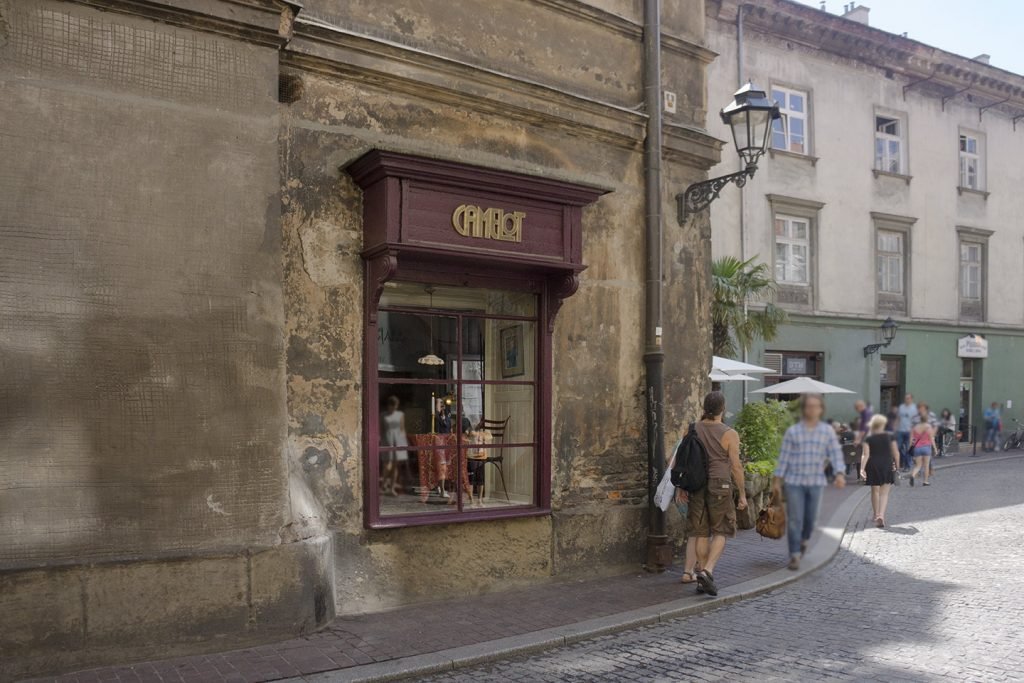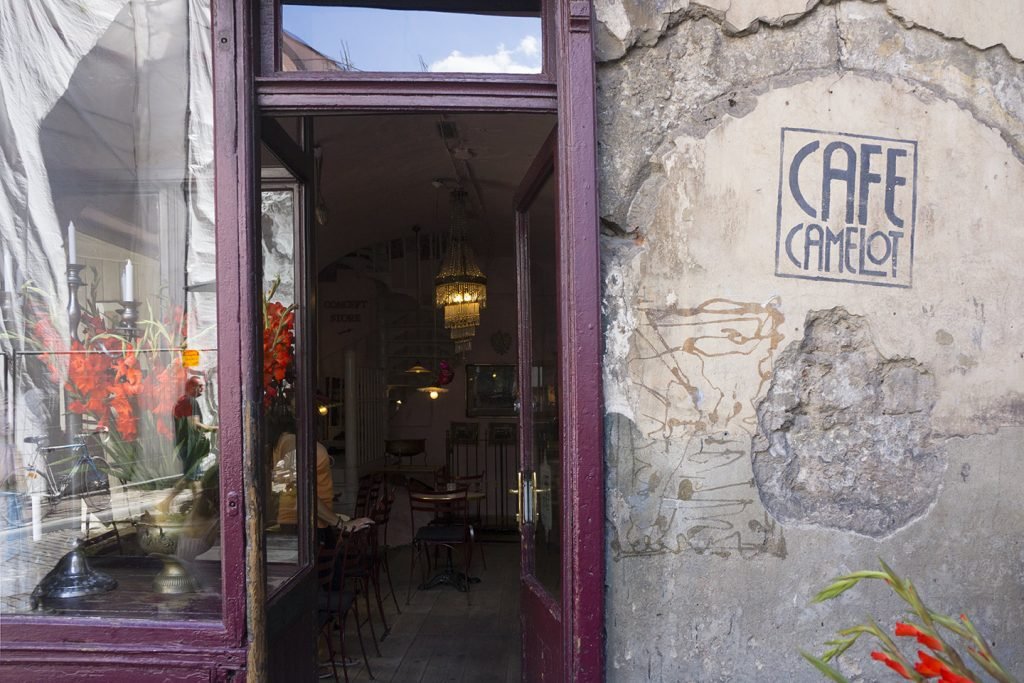Collage
What is it? This is perhaps a question which first comes to your mind – indeed a very good question to begin this lesson.
In this module you’ll get some insights into a fashionable cafe in the old town of Kraków. There are a lot of objects accumulated in one space in a playful arrangement. They may puzzle and surprise you with a unique composition of shapes and colours. You may easily get confused if you start to decipher the meaning and value of the single objects displayed. Instead of seeking understanding try to feel the atmosphere of the place. How does the imaginative design induce uniqueness and distinctive sense of the place? What role do these ‘exhibits’ play?
Let’s look at the furniture, the tables, chairs and cabinets first. Enlarge to see them better. A pretty old set of furniture, isn’t it – would you throw them away or rather keep them as they survived from older times? You wouldn’t renovate them, would you? But would you replace them here with new things? Whatever you propose be consistent – style means consistency.
An old wardrobe with a mirror reflecting some plastic bags on supermarket trolleys – the counterpoints are further accentuated by contrasting colours of the shabby piece of old furniture and jars with some motley stuff inside. What effect would you achieve if you repainted the wardrobe? Or replaced it with a new one? Remember – contrasting doesn’t mean inconsistency. It can be a well-thought design technique.
Are these utensils meant to be used by customers? Unlikely. They may be placed here to further fill the space with objects, not to leave a corner empty? Horror vacui – do you know this feeling – it means fright of emptiness. Imagine they take you to a party and the walls around are blank, nothing around you, would you enjoy the atmosphere? This is the key word here – atmosphere. Objects create a sense of space but you must be aware whom and what purpose the space is going to serve.
Do you know the ‘paste’ function – you copy something, a text or image, and then insert it into another file. Doesn’t it resemble this arrangement? There are a lot of items taken from different contexts accommodated in this room. This is literary pastiche, as popular in the art of today as the ‘paste’ function is in today schools. Obviously, there are authorities in both the fields who strongly reject this method. But let’s face the reality – that’s how many designers play with remnants of the past, like with the wooden furniture in this picture. Just don’t be misled by an apparent simplicity of such playfulness. Consider how the colours, shapes and lines build the space – this is not a random mixture of objects.
Finally let’s go outside to find out where we are. The cafe is at the heart of old town amidst historic buildings with beautiful facades and gates, like the very entrance to the cafe building featuring an impressive blacksmith’s work. The unique character of the cafe is marked on the old wall outside – consider the colours of the wooden frames, how they ‘sound’ against the background. And the background itself – you can inspect the wall if you magnify it – a neglect or art per se?
The cafe filled with all sorts of old objects is actually a very modern interior. Or rather, to be more precise, a very postmodern space. We should say a few words to explain this movement in art which nowadays often pops up as a characteristic approach to objects of the past.
Postmodernism rejects the modernist, avant garde pursuit for the new. Instead of striving for novelty, uniqueness and individuality postmodern designers readily take up forms of the past and use them freely for various purposes. This is often done in a playful ironic arrangement of several traditional styles into one structure. The result of such an approach is a collage – an arrangement of patterns retrieved and recombined from the past. What is necessary for this synthetic approach is a pool of objects or forms and a playful artistic imagination. The aim is not so much to amaze the viewers with originality of a new creation but rather startle them with an unexpected association. Distinctions of various styles gradually dissolve as you submerge into a collective of forms and shapes. You may see it as an anarchic rejection of any authority on what constitutes the ‘right’ order.
As a closing task for this module we’d like to encourage you to design a space yourself using the collage technique.
[bullet_list icon=”play” indent=”10px” style=””]
- First decide what type of space you’d like to create, it can be a cafe, a club, an apartment room, etc.
- Then go to Pinterest which is a visual bookmarking tool that can help you discover and save creative ideas.
- Browse through the available pins which could inspire you to populate your space with objects contributing to a unique ‘feel’ of the environment.
- If you discover a Pin that looks interesting and could enhance your collage arrangement, just save it for further work on the project.
- Then arrange your space using the selected pins with a space designer tool (e.g. SpaceDesigner3D)
- Finally discuss the project with your tutor and colleagues: how the collage technique works in practice, what are the challenges on the way to a quality design.
[/bullet_list]



